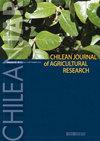Harvest date estimation of ‘Gala’ apples based on environment temperature using artificial intelligence
IF 1.5
4区 农林科学
Q2 AGRICULTURE, MULTIDISCIPLINARY
引用次数: 0
Abstract
Agroclimatic variables in different time windows were analyzed using Artificial Intelligence techniques to estimate the fruit growing season extension and harvest start date for âGalaâ apples (Malus domestica (Suckow) Borkh.) Meteorology and phenology data were collected from five orchards in Central Chile, between 2004 and 2019. The attributes derived from air temperature during the first days of fruit growing season showed the high relationship with harvest start date: The number of hours below 18 °C from full bloom to 35 d after (R = 0.9) and growing degree hours accumulated from full bloom to 45 d (R = -0.84). Different models were developed with these attributes. Simple and multiple linear regression models were the most accurate for explain the length of the total fruit growth period until harvest. The 35 d after full bloom time window was the most effective, with an R2 = 0.82, for estimating harvest start date of âGalaâ apples. These results contribute to the apple growers demand to schedule fruit harvest and processing, especially in a climate change scenario.收获日期估计’苹果会根据环境温度使用人工智能
利用人工智能技术分析了不同时间窗的农业气候变量,估算了加拉苹果(Malus domestica (Suckow) Borkh)的果实生长季延长和收获开始日期。2004年至2019年期间,从智利中部的五个果园收集了气象和物候数据。果实生长季前几天的气温属性与采收开始日期有较高的相关性:从开花到35 d低于18 °C的小时数(R = 0.9)和从开花到45 d累积的生长度数(R = -0.84)。根据这些属性开发了不同的模型。简单线性回归模型和多元线性回归模型最能准确地解释果实总生长期到收获期的长度。充分开花后35 d是预测 gala苹果开始收获日期最有效的时间窗口,R2 = 0.82。这些结果促使苹果种植者要求安排水果收获和加工,特别是在气候变化的情况下。
本文章由计算机程序翻译,如有差异,请以英文原文为准。
求助全文
约1分钟内获得全文
求助全文
来源期刊

Chilean Journal of Agricultural Research
AGRICULTURE, MULTIDISCIPLINARY-AGRONOMY
CiteScore
3.10
自引率
11.80%
发文量
60
审稿时长
6-12 weeks
期刊介绍:
ChileanJAR publishes original Research Articles, Scientific Notes and Reviews of agriculture, multidisciplinary and agronomy: plant production, plant protection, genetic resources and biotechnology, water management, soil sciences, environment, agricultural economics, and animal production (focused in ruminant feeding). The editorial process is a double-blind peer reviewing, Editorial Office checks format, composition, and completeness, which is a requirement to continue the editorial process. Editorial Committee and Reviewers evaluate relevance and scientific merit of manuscript.
 求助内容:
求助内容: 应助结果提醒方式:
应助结果提醒方式:


